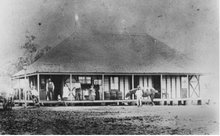Helen Woolcock’s book is stuffed full of information. Reading the chapters on ships and accommodation arrangements, I am overwhelmed by the details. Most interesting to me has been her analysis of the patterns of migrants and of the varying conditions encountered by different types and classes of migrants.
Over 41 years of migration and 1,317 voyages from Britain and Europe, only three Queensland-bound vessels were wrecked (one German and two British). Of course, there were incidents on many other trips. Of these three ships, only the German one lost passengers with 257 of the 282 passengers perishing in a storm off the coast of the Netherlands. The other two ships were able to transfer passengers to other ships.
This highlights the fact that German ships tended to be dedicated migrant ships carrying mostly passengers. Many British ships carried a majority of cargo with a few passengers.
German ships were mainly iron ships with single decks. Passengers often shared a large open dorm room, which gave rise to comments such as those mentioned in The Long Goodbye of the loose moral standards of German ships in contrast to the British.
German ships did prove harder for the Queensland government to regulate, because they were bound by German maritime law and not by British law shared with its colonies. Thus, Queensland government regulations concerning supplies of food and water as well as amount and type of space allocated to migrants could not be enforced on German ships.
However, the 35% of British migrants were single men in the 15 to 29 year old age group. 82% of the migrant population were under the age of 30. Apparently Queensland had quite a reputation as a “marriage mart.”
A higher proportion of the German migrants were family groups. Woolcock’s conclusion is that: “Those who sailed from Hamburg were poorer, older, and included more married couples and children and fewer single people than did their British counterparts. Among the 90 per cent from the United Kingdom, the English and single men predominated. On the whole, it was an influx of young adult manual workers who travelled to the colony wholly or in part at government expense.”
Subscribe to:
Post Comments (Atom)

No comments:
Post a Comment